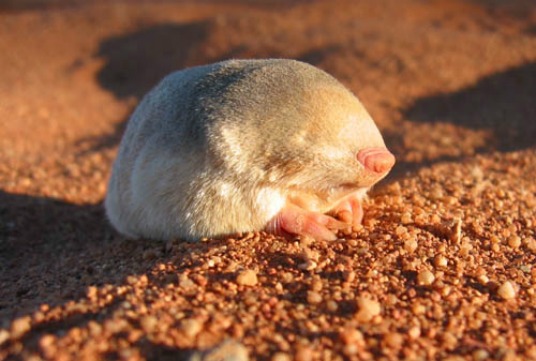Peter Narins once put an ear to the sand in the Namib desert while studying the golden mole, a blind, nocturnal, vibration-sensing furball. He was trying to detect the seismic signals used by the mole to direct its sandy hunt for termites. But without the mole’s unique inner ear, Narins was out of luck. Now, he thinks the mole’s ear could be a model for better earthquake early detection systems.
For nearly four decades, the UCLA neurobiologist has roamed the world, frequenting hard-to-reach destinations in China, Namibia, and Central America as he searches for organisms doing exceptional things. Then, he attempts to understand the biological and evolutionary mechanisms behind their feats.
During his travels, Narins discovered that some of the most exceptional animal behaviors are imperceptible by humans. In China, for example, he found frogs communicating at ultrasonic frequencies far above anything humans could hear. And in Namibia, the golden mole’s ability to sense vibrations produced by desert winds and its favorite meal are likely too subtle to detect with our own ears.
Trained as an electrical engineer, Narins considered a career in radio astronomy. Then he taught for three years as a Peace Corps volunteer in Chile before deciding to pursue neurobiology and behavior at Cornell University. In 1978, Narins joined UCLA’s faculty. He has accrued teaching awards, a Fulbright award, and a Guggenheim Foundation Fellowship.
Narins spoke about golden moles at the February 2011 meeting of the American Association for the Advancement of Science in Washington, D.C. Afterward, he met with SciCom’s Nadia Drake to discuss the extremes of animal communication and the perils of field work.

Photo by Galen Rathbun, California Academy of Sciences
I have a crush on the golden mole.
So do I.
How did you start studying them?
A colleague of mine in South Africa, Jennifer Jarvis—a wonderful woman who’s really influenced me in many ways—said, “Peter, you have to work on the golden mole. This is the animal you want to study.” Of course as soon as I heard about it, I knew we [Narins and longtime collaborator Ted Lewis] had to go and study this animal. And it was wild!
What’s remarkable about it?
We saw the anatomy. It had a huge middle ear. I thought, “Why does it have that and what is it doing?” For someone like me who had been studying hearing in animals, I just looked at that and it was really unusual.
And the mole lives in the Namib desert?
Yes. It’s a fabulous place. You want to go there right now. Trust me.
What do you think is going on with the mole and its ear?
Well, because the moles are blind—without an image-forming eye—and nocturnal, when they’re hungry they need to find these mounds because the mounds contain 99% of the desert’s living biomass. That’s where the food is, like termites. So they need to find these mounds in the dark, and they’re blind. What’re you gonna do? They evolved a phenomenally sensitive ear, based on the large malleus [a middle-ear bone].
What did you find that was new?
People thought the golden moles went out randomly and encountered these mounds. But to me, it didn’t look random. We showed that these animals are using the wind to find them, which blows the dune grass and sets the mounds in resonance, producing vibrations in the sand that moles can detect. They use their ears to detect vibrations in the sand, by performing this behavior called head-dipping [when the mole buries its head in the sand].
How did you show this?
"There’s nothing like observing an animal in its natural habitat. It’s a privilege. Most people don’t do it. You see things you can’t imagine."
We thought the way to nail this down was to produce vibrations in the sand ourselves, with no wind, no mound, no grass. Just record the vibrations with a geophone [which converts ground movement into sound], and play it back into the ground. But we needed something that plays vibrations into the ground as opposed to the air. So I found this thing on the Internet called the "tactile sound transducer." It’s actually purchased most of the time by people in Los Angeles who have far too much money. They mount these things under the floorboards of their house or their car seat, attach it to their stereo, turn on the bass, and the music shakes the house or the chair. And they’re expensive.
I thought it would be so much fun to see the face of the salesman when I ordered ten of these. I didn’t tell him I was going to take them and bury them in the Namib desert.
How subtle are the vibrations the mounds give off? Are they anything a human could detect?
There’s a picture of me [above] in the Namib desert, on a mound, with my ear in the sand listening, to answer that exact question. I couldn’t hear it. I doubt humans could actually hear the vibrations caused by the mound unless we could somehow really get our ears all the way into the sand. If I did head-dipping, held my breath. . . maybe.
How common do you think these vibration communication systems are?
Much more common than we think. But we don’t know. No one’s really worked on it.
Why not?
Because if you can’t hear it, can’t see it—it doesn’t exist for most people. You need instruments. Without instruments you couldn’t hear any of this.
You mentioned the possibility of golden moles being used for earthquake detection. Can you tell me a little bit more about that?
I gave a talk in Taiwan at the National Center for Research on Earthquake Engineering. At the end of it, I challenged the audience to build a model of a golden mole so we could detect the same vibrations, the idea being if a device could mimic the golden mole’s middle ear and detect very low-level vibrations, it might be useful for detecting earthquake precursors [subtle signals preceding the main fault rupture].
Did anyone take you up on your challenge?
Yes. A fellow said he’d be interested in making one of these using MEMS [microelectromechanical systems] technology. He had a facility at Berkeley. I haven’t heard that he’s made one.
Do you think the moles are sensitive enough to detect precursor waves?
Well, we have instruments now that detect earth vibrations. Seismometers are extremely sensitive. The question is, does the golden mole ear have higher sensitivity than the present seismometer? I don’t know the answer. We have some measurements of the malleus, and we do know roughly how much it’s moving and so forth, but we don’t have good measurements of the threshold.
What do you like best about your work?
The idea of doing a correlated study between the behavior of an animal in its natural habitat and the physiological basis of that behavior in the lab. . . there’s nothing like observing an animal in its natural habitat. It’s a privilege. Most people don’t do it. You see things you can’t imagine.
Such as?
We found a population of ultrasonic frogs in a very remote place in central China, near a waterfall. At the bottom is a pool of water with some rocks around it. The frogs are crawling on these rocks, and I go up with my recorder and microphone. One night as I was doing this, the frog jumped away. Now this has happened about a billion times so it’s nothing new. Except this time. The frog jumped about a meter high, right across the pool to the waterfall. He was jumping off the water surface! We all saw it and went, “uhhh…” I’ve had these frogs in my lab, I’ve held them, I’ve picked them up, and I’ve never seen that. They don’t have webbed feet!
There was also a bird, a little forktail. It was walking vertically up the waterfall on the rocks. That was the first strange thing. Normally you don’t see that. Then, about three-quarters of the way up, he walks sideways to one of these rivulets flowing down. He waits at the edge, and then when a shrimp or a fish comes down, he catches it in mid-air.
No way.
Way! It was staggering. We watched the bird for 10 minutes. It was really, really amazing. How does he do that? It’s never been described. Everything you see is new, when you really look. It’s fun.
What are some of the challenges you’ve encountered doing field work?
It’s physically demanding. Dangerous animals. But I will never record frogs at night where there are lions, so that kind of danger doesn’t really exist for me. What do you think is the scariest animal in the world?
I’m guessing the answer’s not what I’d think. . .
Well, everyone thinks something different. Most people guess poisonous snakes or lions or something.
A mosquito?
Very close. You’re as close as anyone has ever gotten. But you can protect yourself from mosquitoes. There are other ones, in the same phylum.
Something flying that bites you?
Not necessarily flying, but it bites you. . . it’s on the ground, usually, in nests. . . .
Ants.
Yes! By far. The worst thing. By far. No brainer.
Fire ants?
Yessss. . . Solenopsis. I stepped on a Solenopsis nest. I was taking bats out of a mist net in Costa Rica and I didn’t realize I was standing right on it. They come out of the nest very quietly and climb up inside your pant legs. They come to about mid-thigh, and then one ant says “now!” and they all bite you—bam!—at once. Your legs are on fire, and it's the most painful thing you can imagine. The only reaction I thought of, which is not a great reaction, is I jumped into a river, thinking it would help. It didn’t help at all. Except that I was very wet and lost all the stuff in my pockets.
What lessons do you bring home from your work in the field?
I think it was Louis Agassiz who said, “Study nature, not books.” I have taken this to heart with my fieldwork. It’s been a great career because it gets me out and takes me to beautiful places around the world where I’ve been lucky enough to study a wide variety of animals and the mechanisms underlying their behavior.
Now, with environmental pressures being so strong, there’s more pressure to understand these animals before they disappear completely. They hold secrets that we don’t have. These animals might teach us how to detect earthquakes earlier, how we can build better hearing aids. Frogs in China and Borneo are teaching us about ultrasound communication. These animals are doing these things naturally. We just have to understand how.
Nadia Drake, a 2011 graduate of the Science Communication Program at UC Santa Cruz, earned her bachelor's degree in biology, psychology, and dance, and her Ph.D. in genetics, all from Cornell University. She was a principal dancer for the Ithaca Ballet. She has worked as a reporting intern at the Santa Cruz Sentinel, San Jose Mercury News, and Nature. She is now the astronomy reporter for Science News in Washington, D.C.
© 2011 Nadia Drake

